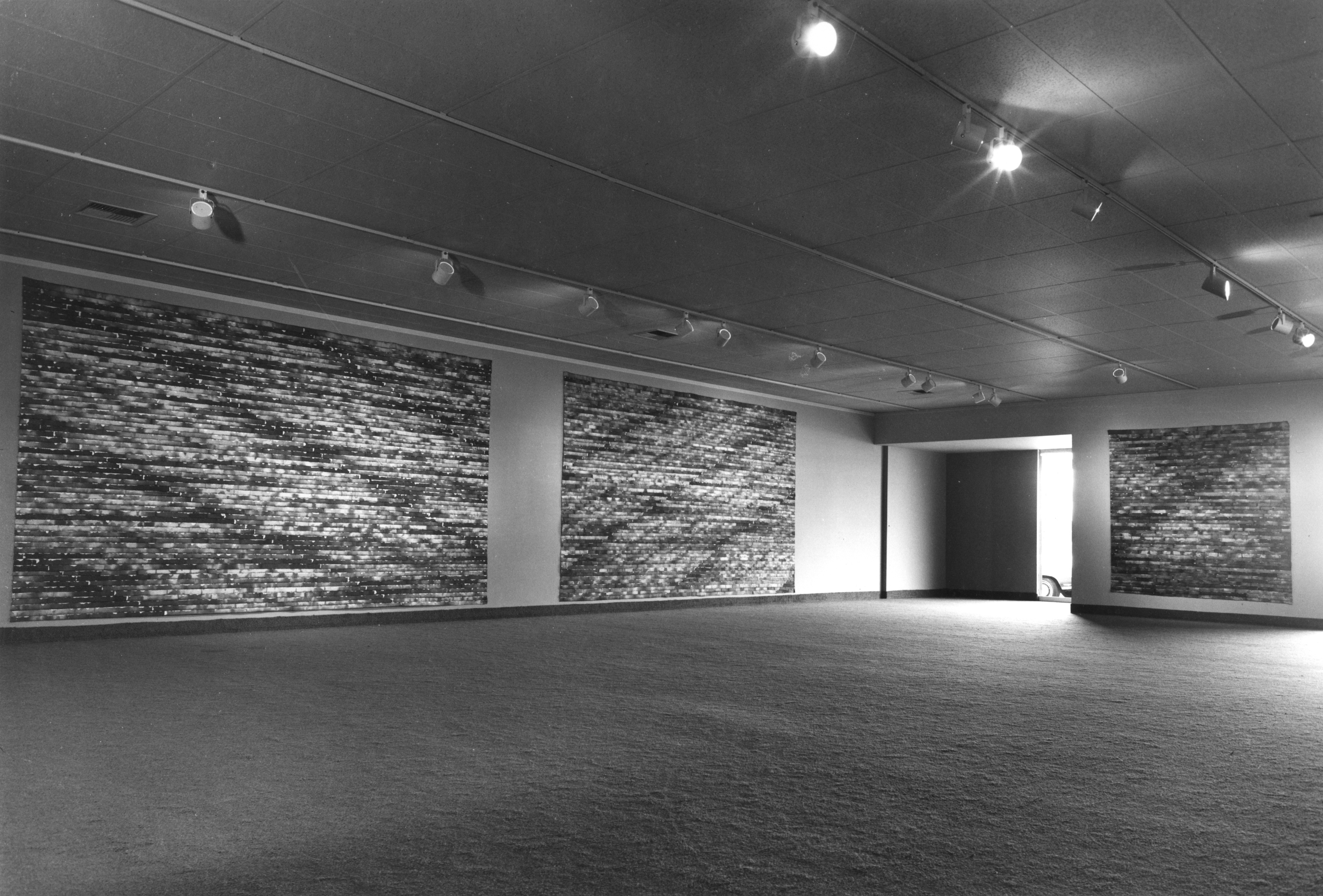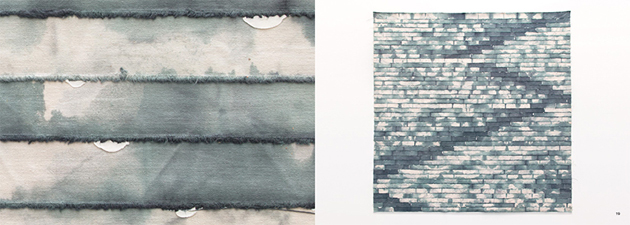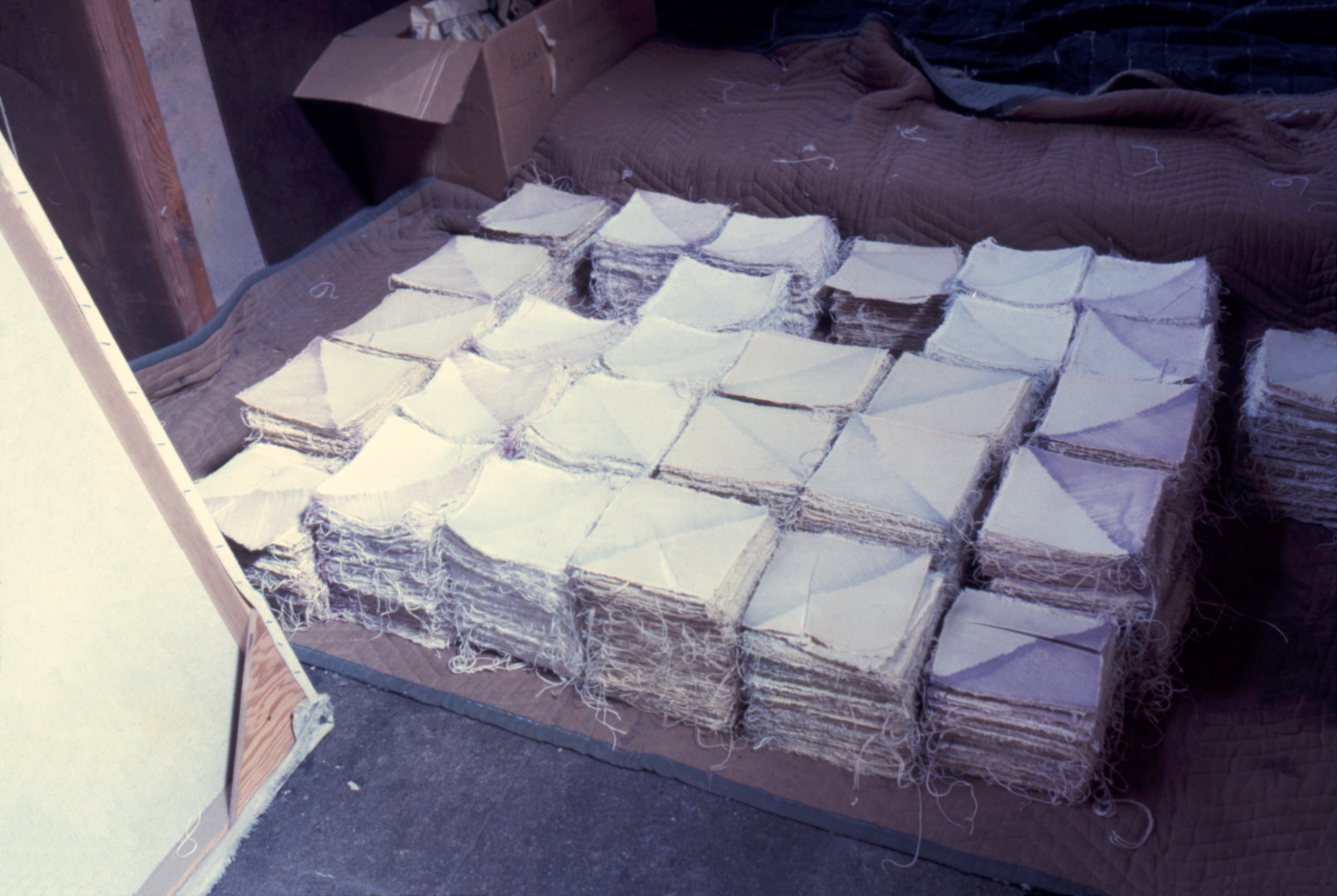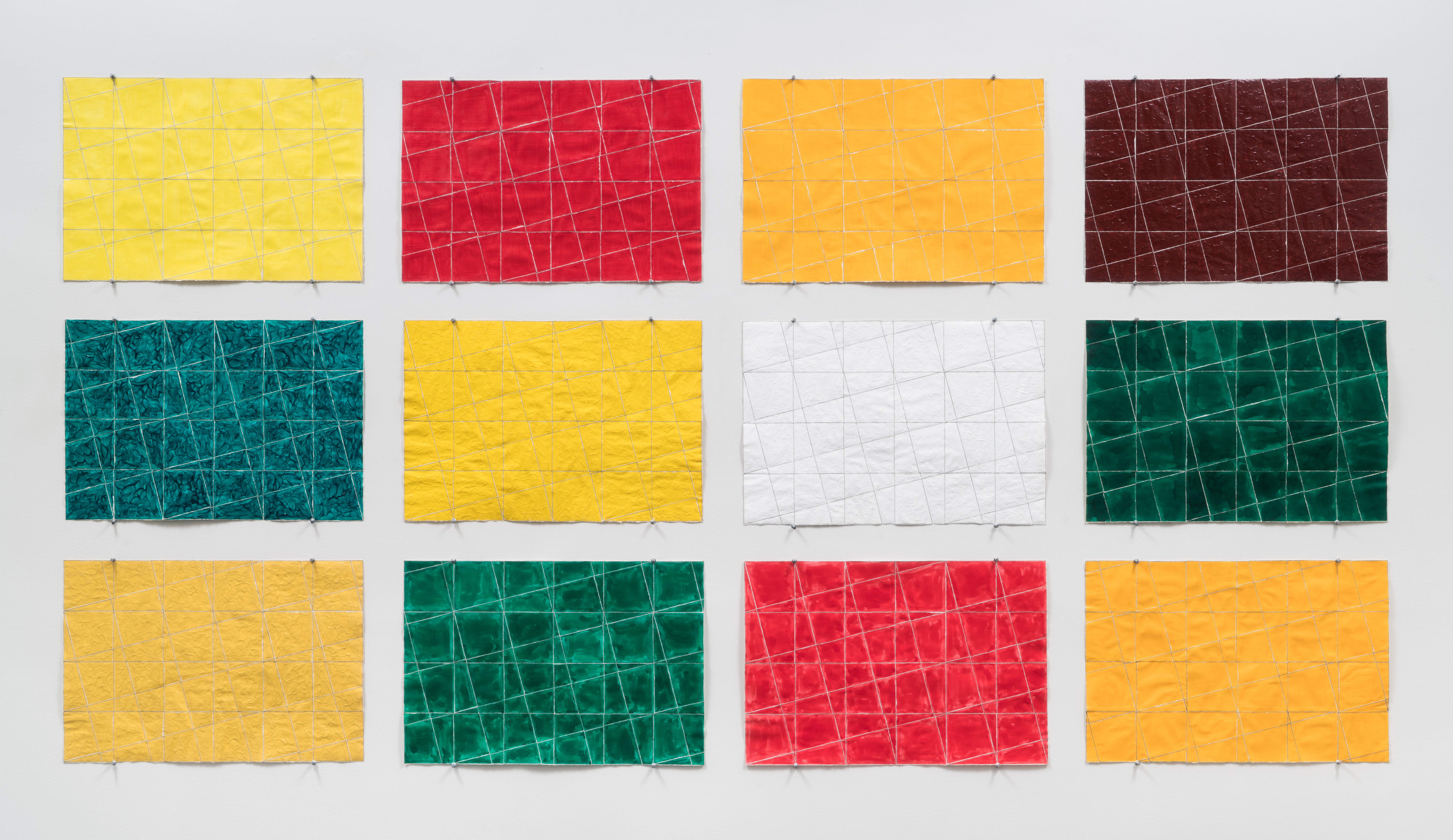Originally published in
Allan McCollum: Works 1968-1977,
Les Presses du réel and Petzel Gallery, © 2017.
Printed here for educational purposes only.

Originally published in |
Download PDF version HERE:  |

Allan McCollum, Constructed Paintings, 1970-71. Installation: Jack Glenn Gallery, Corona Del Mar, California, 1971. Allan McCollum's Unstretched Canvases
MEREDITH MALONE |
||
|
Since Allan McCollum decided to become an artist in 1967, his practice has centered on an insistent drive to demystify the process of art making. "Every project I've done," he stated in a 2001 interview, "has been an inquiry into what it is we look for in an artwork and an attempt . . . to relativize that process and put it into context with other objects that accomplish similar results."1 As a self-taught Los Angeles-based painter in the 1960s, McCollum learned about contemporary art by culling information from art magazines, museums, galleries, and his practical experiences as an art handler. He freely experimented with a hybrid mixture of methods and techniques, describing his approach at this time as "a cross between post-painterly abstraction and post-minimalism."2 Although well-received in the Los Angeles art scene of the late 1960s and 1970s, McCollum's early forays into painting in the form of his Bleach and Constructed Paintings are less known than his subsequent series of Surrogate Paintings (begun in 1978) and Plaster Surrogates (begun in 1982). His earliest paintings represent a vital transitional moment for the artist, linking him to the formalist dialogues of the 1950s and 1960s while anticipating his growing preoccupations with the issues of serial production and strategies of display evinced in his Surrogates and beyond. At the same time, these canvases offer intriguing perspective on the dominant discourses surrounding abstract painting in the beginning of the 1970s and McCollum's aspiration to test and strain them. |
||
 Allan McCollum, Bleach Painting, 1970. Dye and bleach on canvas. |
Citing John Cage as a significant early influence, McCollum began to develop systematic and task-based procedures for producing self-referential artworks: unstretched, stain paintings using raw, industrial, non-art materials available in supermarkets and hardware stores. His Bleach Paintings and Constructed Paintings, both begun in 1969 and made in series, are labor-intensive compositions that suggest the repetitive operations of mass production. These were created at a moment when many artists and critics in the United States and Europe were interested in defining what a painting was by reducing it to it's essential terms, but simultaneously counter this type of formalist investigation. The Bleach Paintings, which McCollum described as "formalist-paintings-as-Fluxus-objects," were based on the establishment of a simple task that when executed resulted in a different outcome each time.3 To create them he first used gray household dye on an unstretched piece of canvas. After masking a series of horizontal stripes with tape, he poured laundry bleach over the entire surface. When the masking tape was removed and the bleach rinsed out, a linear pattern remained, formed by the disappearance of the gray dye where the bleach had soaked into the canvas. System and chance combine in this series to distinct compositions imbued with unforeseen accidents that expose the materials and process of their own making. |
|
|

Detail of a McCollum Constructed Painting, 1971. Pieced together with torn canvas strips, gray dye, and adhesive caulking. |
||
|
Rather than being stretched, McCollum stipulated that these works be stapled flat against the wall. This, and the fact that their size was largely determined by what the strength of the materials would allow, serves to emphasize their two-dimensional character while also heightening the viewer's awareness of them as objects with weight and tactility. The visibility of the caulking and the dangling threads from the tattered edges of the raw canvas blur any distinction between the work's form and the process of fabrication.4 Yet the titles that McCollum gave to many of the works in this series complicate such formalist concerns. According to the artist, he decided to name some of the works after the waitresses at the Troubadour, a nightclub in West Hollywood near where he worked as an art handler, in an attempt to demystify the act of titling an artwork.5 The randomness, levity, and absurdity conveyed by titles such as Pam Beal and Susan Holtz belie McCollum's otherwise highly structured approach. |
||
  McCollum in his studio, 1972. Torn canvas squares with paint stain and varnish, ready to be assembled into Constructed Paintings. |
||
|
In later works in the series, McCollum pieced together six-inch canvas squares (a more direct reference to tilework) stained with different colors and assembled in extended gridded patterns. He joined the squares with thick lines of colored caulking and covered them with course materials such as sand and glitter. McCollum made hundreds of these squares, producing a stockpile of distinct groups that demonstrate a diversity of materials and methods of application, including staining, scraping, and using his fingers to add texture to wet paint. Once sorted into piles, the squares acted as interchangeable parts, akin to a kit that could be mixed and matched to create infinite variations in color, texture, and pattern. A work such as Talking in Tongues (1974), which stretches more than thirteen feet and is covered with a repeating L-shaped pattern accented by different-colored stains, multihued glitter, and patches of gray paint, is both systematic and eccentric, revealing McCollum's interest in sampling while also poking fun at the formalist orthodoxies of contemporary painting.6  Allan McCollum, Talking in Tongues, 1974. Canvas squares, sand, glitter, silicone adhesive, acrylic paint. 72" x 163". |
||
 Remnants III, 1973. Canvas squares, sand, silicone adhesive, acrylic paint. 48" x 43". |
McCollum's unconventional approach and curious mixture of stylistic references were not lost on critics at the time. In a review of a 1974 exhibition of Constructed Paintings at the Nicholas Gallery in Los Angeles, one critic described the artist's unorthodox concoctions as "three-parts abstract expressionism (gestural surface, large scale, overall composition), one part lyrical color, one part process art, one part systematic painting, ... a dash of Hollywood and a smidgeon of concept art."7 Certainly McCollum's application of dyes and bleach to unprimed canvas calls to mind Helen Frankenthaler's stain paintings, the mechanical method of his patterned constructions resembles Frank Stella's minimalist abstractions, the emphasis non mathematical seriality evokes Sol LeWitt's structures, and the over emphasis of process and raw materials points to works by such artists as Eva Hesse, Barry Le Va, Robert Morris, and Richard Serra.8 Although he drew on an extensive array of sources, McCollum recognized intersecting and shared strategies running through his chosen models, including a general thrust towards literalism. "I sensed how different they were, but, on the other hand, the issues were not that dissimilar. There was an interest in literalism, in Helen Frankenthaler's concern with the honesty of the materials of painting, compared to, say, Robert Morris's interest in 'making.' There's a whole lot of parallels if you haven't been trained to think one way or the other."9 |
|
 Constructed Painting: If Love Had Wings: A Perpetual Canon, 1972. Canvas squares, lacquer stain, varnish, silicone adhesive caulking. 110 x 331 inches. Installation: Pasadena Art Museum, 1972. |
||
|
McCollum was one of a number of artists in Europe and the United States concurrently, if independently, testing accepted tenets of painting through experimentation with unstretched surfaces, with unconventional material, and unique display strategies. While espousing an array of motives, from decorative investigations to more pointed attempts at demystifying art, this international development was largely characterized at the time by critics as a response to Abstract Expressionism (most notably Jackson Pollock's allover paintings executed on large unstretched canvases laid out on the floor) and the ensuing influence of color-field painting, also known as post-painterly abstraction. As early as 1953, Frankenthaler, followed by Morris Louis, Kenneth Noland, and Jules Olitski, adopted the method of applying thin washes or stains of color to large pieces of unprimed canvas, letting paint literally fuse with the support. The resultant works stressed pictorial flatness, frontality, and "opticality," a construct proposed by art critic Clement Greenberg in his influential 1960 essay "Modernist Painting," which championed a formalist notion that painting advances only insofar as it reflects on its own properties as a medium, namely flatness and the privileging of a purely optical experience.10
|
||
 Manifestation 3, Daniel Buren, Olivier Mosset, Michel Parmentier and Niele Toroni, presented in the theater at Musée des Arts Décoratifs, Paris, June, 1967. © Photo Bernard Boyer, Paris. |
||
|
In France, two major artist groups formed in the mid-1960s — Supports/Surfaces, whose members included Daniel Dezeuze, Noël Dolla, and Claude Viallat, among others, and BMPT (an acronym for Daniel Buren, Olivier Mosset, Michel Parmentier, Niele Toroni). Working at a time of violent political change for France and its colonies, these artists employed the language of Greenbergian modernism in order to subvert it, explicitly rejecting the notion of art as reserved for an elite.11 The members of Supports/Surfaces used industrial and household fabrics, dyes, and other unusual materials, deconstructing the act of painting to its essential properties in an attempt to divest art of its symbolic and romantic qualities. They often displayed their works outside established gallery spaces, organizing open-air exhibitions in small towns in the South of France and espousing a commitment to revolutionary social change (most of the group were Maoists).12 BMPT also challenged the elevated nature of painting, creating art that was simple and self-evident through the implementation of straightforward systems, such as the use of neutral, repetitive motifs.13 In doing so, they sought to make canvases that drew attention away from the object and towards the operations and spaces of the museums and galleries that showed them, thus highlighting the social and cultural content of painting. In Los Angeles, the move "off the stretcher" was undertaken as a means of advancing a fatigued tradition of abstraction while also challenging the slick, precise art known as Finish Fetish or "the LA Look" then dominating the local art scene.14 As reflected in a series of group exhibitions mounted throughout the 1970s on the theme of "soft" painting in Southern California, artistic explorations with unstretched surfaces covered a range of divergent approaches in terms of both method and material.15 While some artists used paint, others incorporated cast polyester resin, nylon, fiberglass cloth, and paper, often slashing, sewing, wrinkling, or pasting their chosen medium. In many cases, this experimentation resulted in lyrical compositions that stressed both plastic and metaphysical concerns. McCollum's interests, on the other hand, were always more structural, driven by a systematic approach and an ultimate desire to push painting's literalness toward more conceptual ends. His practice of staining and his attention to the flatness of the unstretched canvas evince only a superficial link to the tenets of post-painterly abstraction, one that actually refuses such an overdetermined emphasis on flatness and opticality.16 His use of non-art, craft-based materials in his paintings, coupled with his choice of titles, reveal a pointed irreverence motivated by a desire to question the formalist theory of painting as autonomous, completely divorced from the world outside its borders. |
||
 Allan McCollum, Twelve Untitled Paper Constructions, 1975. 16" x 24" each. Acrylic paints, colored pencils, and watercolors on paper, and each pieced together from 24 preprinted parts. |
||
  96 shapes were drawn and offset printed on bristol drawing paper. Each shape painted in by hand, and torn out to construct the Untitled Paper Constructions. |
||
|
With his Paper Constructions, begun in 1974, McCollum extended the systematic procedures used in his unstretched paintings while amplifying his focus on the intertwined issues of originality, serial production, and standardization. Employing variations on sixteen basic geometric shapes that were first drawn on graph paper and then commercially printed in quantity on drawing paper, he devised a system for generating a plethora of hand-made works, a type of "unique multiple." McCollum painted the shapes or covered them with graphite, then tore them out along their outlines and glued them together like pieces of a puzzle. The shapes could be used again and again to produce an unlimited number of variations in composition, color, and size. The use of permutational systems relates to the conceptual methods of LeWitt. The reduction of formal elements to standardized components that are repeated points, as McCollum himself has noted, toward the practice of a figure such as Buren, whose striped canvases made from ready-made fabric of alternating white and colored vertical bands (unstretched and unframed) questioned ideas of rarity and originality used to determine the value of a work of art, along with the institutional frames that traffic in such values.17 It was, in part, by working through the self-reflective inquiry demonstrated in his Constructed Paintings and the serial production of his Paper Constructions that McCollum became increasingly conscious of how process and the context-dependent contingency of all objects inform practice at multiple levels, from the studio to the systems that support the institutions of art. After testing an amalgam of formalist, Minimalist, and Postminimalist strategies, he arrived at his more conceptually driven Surrogate Paintings in the late 1970s, consisting solely of a minimal frame, mat, and rectangle in lieu of an actual image. These objects exist as proxies for paintings, but also for any kind of standard cultural object that is framed and hung on a wall.18 They were soon followed by the Plaster Surrogates, which were cast in plaster using rubber molds taken from select Surrogate Paintings. Superficial variations in size and color ensure that each Surrogate is distinct.19 Although the production of unique objects in quantity was presaged in his Paper Constructions, with the introduction of the plaster cast McCollum began to produce a superabundance of generic yet customized objects. The Surrogates marked his move beyond a preoccupation with form and content to a critical focus on the strategies and systems through which objects, artistic or otherwise, are more broadly assigned meaning and worth in contemporary culture. The literalism demonstrated in his earliest series was ultimately displaced by the Surrogates as McCollum moved from an emphasis on process and the unstretched canvas to an exploration of the devices that frame the things we make, collect, and value, both literally and figuratively.20 |
||
|
Endnotes
1. Allan McCollum quoted in Robert Enright, "No Things but in Ideas: An Interview with Allan McCollum," Border Crossings, no. 20 (August 2001): 37. 2. Ibid., 31. 3. McCollum quoted in Anne Rorimer, "Self-Referentiality and Mass Production in the work of Allan McCollum, 1969-1989," in Allan McCollum (Eindhoven, Netherlands: Stedelijk Van Abbemuseum, 1989), 8. 4. As McCollum described it, "There was no way to distinguish the work's composition from the features of its fabrication." Ibid. 5. Allan McCollum, email correspondence with the author, April 28, 2010. 6. The titles of these works, including Talking in Tongues, The Gift of Tongues, and Glossolalia, further emphasize McCollum's mixture of unrestricted experimentation and wit. They reference biblical descriptions of people channeling spirits, which McCollum has connected to the mixture of artistic languages he employed in the paintings. Email correspondence with the author, January 13, 2017. 7. Sandy Bellatore, "Allan McCollum: Gourmet Art," Artweek, December 14, 1974, 5. 8. Morris, Serra, Hesse, and Le Va were all included in the groundbreaking exhibition Anti-Illusion: Procedures/Materials, on view at the Whitney Museum of Art in New York City, May 19-July 6, 1969. The exhibition and its catalogue were incredibly influential, the latter including copious photographs of works in the exhibition as well as artists in the process of making them. 9. McCollum, in Enright, "No Things," 32. 10. According to Greenberg, modernist painting progressed only to the extent that it reflected on its own properties as a medium. The one characteristic unique to painting is its flatness of the picture plane, which privileges a purely optical experience without body involvement. See Clement Greenberg, Modernist Painting, (1960), in The Collected Essays and Criticism, vol. 4, ed. John O'brian (Chicago: University of Chicago Press, 1993), 85-93. 11. The mid-1960s, France was involved in wars in Indochina and Vietnam and was experiencing rising unease about encroaching American cultural imperialism. 12. McCollum was unaware of Supports/Surfaces until his work was included in the exhibition Unstretched Surfaces: Los Angeles–Paris, held at the Los Angeles Institute of Contemporary Art, November 5 - December 16, 1977. 13. These include Daniel Buren's vertical stripes, Michel Parmentier's horizontal bands, Niele Toroni's distributed brushstrokes of equal dimension, and Olivier Mosset's black circle in the middle of a canvas. 14. For an overview of these tendencies in Southern California art, see Howard N. Fox, "Tremors in Paradise, 1960-1980," in Made in California: Art, Image, and Identity, 1900–2000, ed. Stephanie Barron, Sheri Bernstein, and Ilene Susan Fort (Los Angeles: Los Angeles County Museum of Art; Berkeley: University of California Press, 2000), 193-234. See also Peter Plagens, Sunshine Muse: Contemporary Art on the West Coast (New York: Praeger, 1974). 15. Exhibitions include Off the Stretcher, Oakland Museum (1971-72), and 24 Los Angeles Artists, Los Angeles County Museum of Art (1971). The exhibition Unstretched Surfaces: Los Angeles–Paris (1977) recognized the parallel in the "concept and practicality of the non-stretched surface" in LA and France. See Jean-Luc Bordeaux, Unstretched Surfaces: Los Angeles–Paris, (Los Angeles Institute of Contemporary Art, 1977), 5. Examples of McCollum's constructed paintings were included in each of these exhibitions. 16. McCollum was well versed in these practices. His work was exhibited at the Nicholas Wilder Gallery in the early 1970s, which was among Los Angeles's leading contemporary art venues in the 1960s and 1970s. Wilder exhibited the work of numerous painters championed by Clement Greenberg and associated color-field Painting, including Helen Frankenthaler, Barnett Newman, Kenneth Noland, and Jules Olitski. 17. McCollum's growing interest in the context of an artwork–the idea that the meaning of a work resides in the role it plays in the larger culture–was informed, in part, by Buren and the practices of the BMPT. He read about a series of performances staged by BMPT in Paris in 1967 in an article by Otto Hahn, "All or Nothing," Arts Magazine, (Summer 1968), 38-40. See Lynne Cooke, "Allan McCollum: The Art of Duplicitous Ingemination," in Allan McCollum, 17. 18. McCollum established an objective distance from painting with his Surrogates, often describing his approach as an attempt to imagine "how an anthropologist from Mars might look at what we call 'walls' and what we attach to them." Email correspondence with the author, January 25, 2017. 19. The Surrogate Paintings were painted either allover as single-color monochromes (1978-79) or with black centers (1980-1981). The Plaster Surrogates were made in twenty standard sizes with black centers and different-colored mats and frames (140 frame colors and a dozen mat colors), but McCollum has occasionally produced variations on this latter series as single-color monochromes. 20. For an insightful analysis of the shift at this time in artistic practice towards an analysis of the systems and relations of artistic production more broadly, see Craig Owens, "From Work to Frame, or, Is There Life After 'The Death of the Author'?," in Beyond Recognition: Representation, Power, and Culture (Berkeley: University of California Press, 1992), 12-39. |